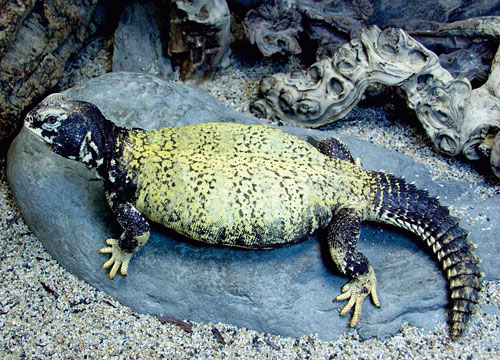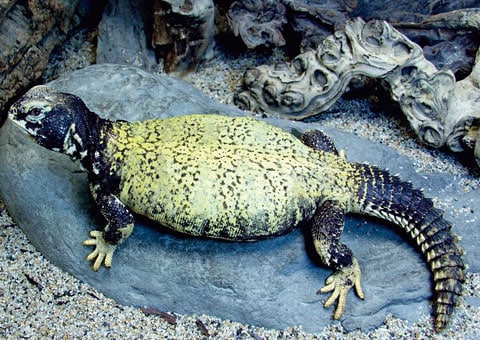Breeding the Mali uromastyx (Uromastyx dispar maliensis) lizard.
 |
Mali uromastyx (Uromastyx dispar maliensis) entered the pet trade in the mid-1990s. Their hardiness and inexpensive price, coupled with an endearing temperament, led them to become the most abundant Uromastyx species in captivity in just a few short years.
Originating from Mali, Africa, the bulk of this Uromastyx species’ native range is hot, arid, broken scrublands characterized by rocky outcrops poking through otherwise fractured stone, clay and sand soils. Surface temperatures can exceed 120 degrees Fahrenheit during the summer and occasionally drop to near 32 degrees during the coldest winter nights. The lizards avoid these seasonal extremes by digging burrows, often 1 foot deep and up to 3 feet long, in the hard-packed soils.

Douglas Dix
Found in Mali, Africa, Mali uromastyx lizards occur in hot, arid and broken scrublands.
Adult Mali uromastyx measure between 11 and 15 inches in total length with an average body weight of 7 to 14 ounces.
As juveniles Mali uromastyx display a camouflage pattern of charcoal spotting on a gray background. Reared in their natural habitat, females retain this coloration. However, if reared in captivity, both sexes consistently develop jet-black heads, legs, tails and sides as they mature. Only their backs and bellies follow a more varied path. Most develop predominately black backs covered in yellow dots. A few reverse this pattern and have predominately yellow backs covered in black spotting, which vary from simple solid freckles to hollow honeycomb and eyespot shapes. Some develop solid-white bellies. Others have bellies solid black, solid yellow, tiger-striped black on yellow, or black on white.
Sexing Tips
- Mali uromastyx generally must be longer than 10 inches and more than 5¼ ounces to breed successfully. This takes about three years in captivity. Although they often breed communally in the wild, they do best if kept as true pairs year round in captivity.
- Determining sex is tricky at first. Both sexes possess femoral pores, and when reared in captivity, coloration is no longer a reliable indicator of sex.
- Looking for hemipenal bulges under the tail is the safest sexing method. Gently arch the tail over the lizard’s back. Study the underside of the tail just behind the vent opening. With females you’ll see the base of two ligaments, one on each side of the vent, angling down toward the tail tip. Just their base is visible, so it will look like a small upside-down V sitting just above each corner of the vent. With males the hemipenes sit on top of these ligaments, largely masking them. In this case, the pattern looks more like two parallel lines sitting just above the vent pointing toward the tail tip.
Bring the Heat
Mali uromastyx do best in habitats measuring at least 48 inches long, 24 inches wide and 14 inches tall. We at Deer Fern Farms prefer small, round birdseed (millet) for the bedding, but washed playground sand also works. Keep it shallow because you don’t want lizards to burrow in these substrates, which don’t safely hold up. For burrows, make small cavelike ceramic or natural-rock hides at the cool end of the enclosure. Make them around 2 inches tall and large enough in diameter to allow the animal to easily fit inside when slightly curled up.
We use one mercury vapor bulb, which emits heat and UVB, for the basking spot. Choose a wattage that will heat this spot to 115 degrees Fahrenheit, plus or minus 5 degrees. The main central area of the habitat floor should be around 95 to 100 degrees, and the surface under the hide at the cool end should be 90 degrees, plus or minus 5 degrees. All lights need to turn off at night, but maintain a nighttime temp above 70 degrees. A ceramic heat emitter or an undertank heating pad can supply supplemental heat if necessary.
Mali uromastyx do best if maintained below 30 percent humidity, but they are tolerant of higher humidity as long as the cage is dry and the temperatures are in the preferred ranges. They do not tolerate being cool and damp.
Mali uromastyx are adapted to obtain moisture from their diet, so water bowls are not a necessity. Under typical indoor housing conditions, water bowls are actually detrimental to their long-term health. As a precaution, we offer them a soak outside the habitat once every few weeks. The 100-degree water should be less than 1 inch deep. This soak allows them a drink if needed and helps to ensure clean sheds.
Build a Solid Base
We offer once a day a base diet containing a 50-50 mix of spring greens and chopped endive. To this we add 5 percent warmed, mixed frozen veggies (peas, chopped carrots, corn and green beans) plus mixed yard weeds (dandelion greens, clover, plantain, chickweed and wild mustard). We also add pesticide-free edible flowers (nasturtiums, hibiscus, violas, roses, dandelions and clover) when in season. The final mix is misted with fresh water and placed in a shallow bowl near the middle of the habitat.
We supplement the diet of the Mali uromastyx daily with a light dusting of Miner-All calcium and mineral powder, which contains low levels, 4,000 international units, of vitamin D3. Every third day we dust with a vitamin mix called Uromastyx Dust.
Set the Mood
Set up a breeding pair of Mali uromastyx as described, but add a nestbox in the cool end instead of the normal, cavelike hide.
The most practical nesting area for a Mali uromastyx is a completely self-enclosed tub. A 10-gallon soft-plastic tub with lid intact works well. Cut a 4-inch-diameter hole in the upper side, and attach a similar-sized flexible drainpipe to the hole to allow entry from ground level. Fill the box two-thirds full with a 50-50 mix of washed playground sand and peat moss. Adding 10 percent caliche soil makes it more attractive to nesting females. Add water until the substrate is slightly moist to the touch.
Although Mali uromastyx kept as pets can have a 12-hour photoperiod year round, put the lizards through an artificial winter to initiate breeding. Begin by dropping day lengths by one to two hours each week, either a few minutes each day or all at once each weekend, until they’re down to four to six hours of daylight.
Steadily decrease the average daytime ground temperature over this same time period until the mid-80s is the daily high. Nighttime lows should also drop 2 to 3 degrees each week and eventually be in the high 60s. Nighttime temperatures should persist throughout the night and most of the day. The exception is when basking lights are on, and temperatures climb back into the mid-80s.
During the early stages of Mali uromastyx brumation, we offer food every second or third day, and we offer normal amounts at the accustomed feeding time, usually midmorning. When the lizards are down to six hours of daylight, we stop feeding completely. Full brumation proceeds for another 60 days. After that, reverse the process. Add a daylight hour or two per week while gradually increasing the background habitat temperatures until the summer norms are reached.
Wait and Incubate Eggs
Breeding usually occurs right before you reach the normal 12-hour day. Male Mali uromastyx often head-bob at the female Mali uromastyx, especially in the early morning, and actual copulations are easy to miss.
Gestation lasts an average of four weeks before the female lays a single clutch of 10 to 20 eggs. Remove the Mali uromastyx eggs and the nestbox as soon as she finishes burying them.
Prepare an incubation medium from slightly damp vermiculite or HatchRite cut with activated charcoal and 10 percent dry perlite. Fill a Tupperware container measuring 11 inches long, 7 inches wide and 4 inches tall about two-thirds full with this mix, and bury the eggs on their sides until only a small portion of each egg is visible. Original orientation of the Mali uromastyx eggs is not important, but handle them as little as possible. Put the lid on the container. No air holes are necessary.
Incubate the container at 92 degrees. Pop the lid once a week to circulate air and to look for any obviously bad Mali uromastyx eggs. Eggs more than 25 percent caved in, leaking fluid, or with fungal or bacterial growth are bad.
Tend to the Mini Malis
Mail uromastyx babies hatch in 60 to 80 days and require the same housing and feeding conditions as the adults. We make only two modifications. Paper towels are the substrate, and a half-inch-deep water dish is provided for the first two months.
Eight to 10 hatchling Mali uromastyx can be kept in a tank 4 feet long, 2 feet wide and 1½ feet tall. We remove two individuals every two to three months as they grow.
Most Mali uromastyx seek food within 24 hours of hatching. We offer the same diet given to adults, but we offer it twice per day: midmorning and midafternoon.
All in all, Mali uromastyx can be a rewarding species to work with. One of the hardier Uromastyx species, they are relaxed and receptive to their keepers. Regulations have closed off further export, so captive breeding of this species is more important than ever.


